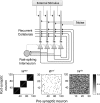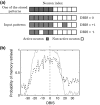Transitory memory retrieval in a biologically plausible neural network model
- PMID: 24427215
- PMCID: PMC3773321
- DOI: 10.1007/s11571-013-9244-2
Transitory memory retrieval in a biologically plausible neural network model
Abstract
A number of memory models have been proposed. These all have the basic structure that excitatory neurons are reciprocally connected by recurrent connections together with the connections with inhibitory neurons, which yields associative memory (i.e., pattern completion) and successive retrieval of memory. In most of the models, a simple mathematical model for a neuron in the form of a discrete map is adopted. It has not, however, been clarified whether behaviors like associative memory and successive retrieval of memory appear when a biologically plausible neuron model is used. In this paper, we propose a network model for associative memory and successive retrieval of memory based on Pinsky-Rinzel neurons. The state of pattern completion in associative memory can be observed with an appropriate balance of excitatory and inhibitory connection strengths. Increasing of the connection strength of inhibitory interneurons changes the state of memory retrieval from associative memory to successive retrieval of memory. We investigate this transition.
Keywords: Associative memory; Recurrent network; Successive retrieval of memory; Transitory dynamics.
Figures





Similar articles
-
Robust Associative Learning Is Sufficient to Explain the Structural and Dynamical Properties of Local Cortical Circuits.J Neurosci. 2019 Aug 28;39(35):6888-6904. doi: 10.1523/JNEUROSCI.3218-18.2019. Epub 2019 Jul 3. J Neurosci. 2019. PMID: 31270161 Free PMC article.
-
Multiscale and Extended Retrieval of Associative Memory Structures in a Cortical Model of Local-Global Inhibition Balance.eNeuro. 2022 Jun 8;9(3):ENEURO.0023-22.2022. doi: 10.1523/ENEURO.0023-22.2022. Print 2022 May-Jun. eNeuro. 2022. PMID: 35606151 Free PMC article.
-
Dynamics of the CA3 pyramidal neuron autoassociative memory network in the hippocampus.Philos Trans R Soc Lond B Biol Sci. 1994 Jan 29;343(1304):167-87. doi: 10.1098/rstb.1994.0019. Philos Trans R Soc Lond B Biol Sci. 1994. PMID: 8146234
-
Associative memory in networks of spiking neurons.Neural Netw. 2001 Jul-Sep;14(6-7):825-34. doi: 10.1016/s0893-6080(01)00064-8. Neural Netw. 2001. PMID: 11665774 Review.
-
Modelling studies on the computational function of fast temporal structure in cortical circuit activity.J Physiol Paris. 2000 Sep-Dec;94(5-6):473-88. doi: 10.1016/s0928-4257(00)01098-6. J Physiol Paris. 2000. PMID: 11165914 Review.
Cited by
-
Models of human hippocampal specialization: a look at the electrophysiological evidence.Trends Cogn Sci. 2025 Jun;29(6):556-569. doi: 10.1016/j.tics.2024.11.009. Epub 2024 Dec 12. Trends Cogn Sci. 2025. PMID: 39668062 Review.
-
A simplified computational memory model from information processing.Sci Rep. 2016 Nov 23;6:37470. doi: 10.1038/srep37470. Sci Rep. 2016. PMID: 27876847 Free PMC article.
-
Exponential synchronization of memristive Cohen-Grossberg neural networks with mixed delays.Cogn Neurodyn. 2014 Jun;8(3):239-49. doi: 10.1007/s11571-013-9277-6. Epub 2014 Jan 4. Cogn Neurodyn. 2014. PMID: 24808932 Free PMC article.
References
-
- Amari S. Characteristics of random nets of analog neuron-like elements. IEEE Trans Syst Man Cybern. 1972;SMC-2:643–653.
-
- Amit DJ. The Hebbian paradigm reintegrated: local reverberations as internal representations. Behav Brain Sci. 1994;18:617–626. doi: 10.1017/S0140525X00040164. - DOI
-
- Anderson JA. A simple neural network generating an interactive memory. Math Biosci. 1972;14:197–220. doi: 10.1016/0025-5564(72)90075-2. - DOI
LinkOut - more resources
Full Text Sources
Other Literature Sources

